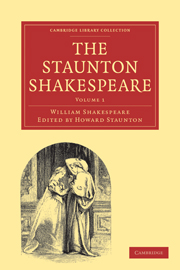Book contents
- Frontmatter
- Contents
- PREFACE
- SOME ACCOUNT OR THE LIFE OF SHAKESPEARE
- SHAKESPEARE'S WILL
- PRELIMINARY MATTER IN THE FOLIO OF 1623
- THE ADDRESS TO THE READER
- COMMENDATORY VERSES
- ADDENDA AND CORRIGENDA
- THE TWO GENTLEMEN OF VERONA
- LOVE'S LABOUR'S LOST
- THE COMEDY OF ERRORS
- ROMEO AND JULIET
- THE TAMING OF THE SHREW
- KING JOHN
- A MIDSUMMER NIGHT'S DREAM
- THE MERCHANT OF VENICE
- KING RICHARD THE SECOND
- THE FIRST PART OF KING HENRY THE FOURTH
- THE SECOND PART OF KING HENRY THE FOURTH
- THE MERRY WIVES OF WINDSOR
- MUCH ADO ABOUT NOTHING
THE TAMING OF THE SHREW
Published online by Cambridge University Press: 29 August 2010
- Frontmatter
- Contents
- PREFACE
- SOME ACCOUNT OR THE LIFE OF SHAKESPEARE
- SHAKESPEARE'S WILL
- PRELIMINARY MATTER IN THE FOLIO OF 1623
- THE ADDRESS TO THE READER
- COMMENDATORY VERSES
- ADDENDA AND CORRIGENDA
- THE TWO GENTLEMEN OF VERONA
- LOVE'S LABOUR'S LOST
- THE COMEDY OF ERRORS
- ROMEO AND JULIET
- THE TAMING OF THE SHREW
- KING JOHN
- A MIDSUMMER NIGHT'S DREAM
- THE MERCHANT OF VENICE
- KING RICHARD THE SECOND
- THE FIRST PART OF KING HENRY THE FOURTH
- THE SECOND PART OF KING HENRY THE FOURTH
- THE MERRY WIVES OF WINDSOR
- MUCH ADO ABOUT NOTHING
Summary
The earliest copy of this diverting comedy in its present form, yet known, is that of the folio 1623; but in the year 1594 was printed an anonymous play entitled “A Pleasant Conceited Historic, called The taming of a Shrew. As it was sundry times acted by the Right Honorable the Earle of Pembrook his seruants. Printed at London by Peter Short and are to be sold by Cutbert Burbie, at his shop at the Royall Exchange, 1594,” quarto, which from its remarkable resemblance to the drama acknowledged to be Shakespeare's, may be looked upon almost as a previous edition of the same play. The “Pleasant Conceited Historie,” of 1594, has an Induction, the characters of which are, a Noble man, Slie, a Tapster, Page, Players, and Huntsmen. The incidents of this Prelude, and the story, the characters, and the events of the play that follows—with the exception of an underplot taken from George Gascoigne's translation of Ariosto's “II Suppositi,” —all so closely resemble those in Shakespeare's drama, that one was evidently framed upon the other. This remarkable similarity, both in the titles and the contents of these two productions, has been the occasion of much interesting perquisition. The first impression would naturally be that they were by the same hand, and that the latter, wonderfully improved in the spirit of the dialogue and the ease and flow of the verse, was only a revised edition of the other.
- Type
- Chapter
- Information
- The Staunton Shakespeare , pp. 223 - 280Publisher: Cambridge University PressPrint publication year: 2009First published in: 1858

